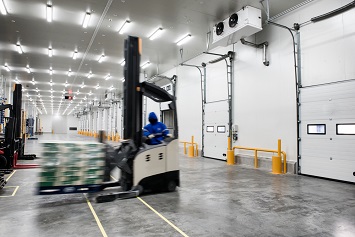For manufacturing plants, warehouses, and distribution centers, loading docks are the center of the action—the hub for receiving and unloading freight. Loading docks can be exterior or fully enclosed in a receiving bay, and they are typically located near a storage room or staging area. They can also be one of the more dangerous areas within a facility.
The loading and unloading of semitrailers are arduous and fast-paced tasks, which typically involve a forklift or other material-handling equipment. Establishing clear loading dock safety procedures can help reduce the likelihood of an employee getting hurt on the job.
Here are five loading dock safety tips to help keep employees safe:
- Provide proper forklift training. Powered industrial trucks, such as forklifts, motorized pallet jacks, or lift trucks, cause more than 100,000 injuries every year. The Occupational Safety and Health Administration (OSHA) mandates that only trained and competent drivers may operate powered industrial trucks. OSHA also requires business owners to provide training specific to the vehicle being used, and for operators to demonstrate competency in lift operation. Refresher courses must be held every 3 years or if an operator demonstrates unsafe handling. There are many private companies that provide training courses in forklift safety. Employees may also be able to take a forklift safety class at a local community college or trade school.
- Load and unload safely. Workers should be trained in loading dock safety procedures specific to the type of freight a business ships or receives. For any cargo, the appropriate lift truck or handcart should be used to avoid muscle strain. When lifting cargo, workers should bend at their knees and lift with their legs—not with their backs. Special caution and training are necessary when handling flammable or combustible materials. For more information on proper loading and unloading techniques, see OSHA’s comprehensive pocket guide to warehouse worker safety.
- Keep the dock clean, dry, and in good repair. According to the Bureau of Labor Statistics (BLS), slips, trips, and falls account for more than 25 percent of all workplace accidents each year, and they are among the most common causes of on-the-job injury. Regularly inspect loading docks and repair any noticeable damage, like worn bumpers, potholes, or uneven levelers. Sweep or mop up spilled debris and liquids immediately. Kitty litter can help absorb oily spills before cleanup. Place signs or cones near spills to warn workers.
- Use wheel chocks. Wheel chocks are wedges of heavy-duty material that fit snugly against the center of the tire in the direction of the grade, on the left and right side of the vehicle to help prevent movement during freight transfer. On even surfaces, chocks are applied to the rear-facing as well as the front-facing side of each tire. They are an important safety precaution, and OSHA enforces wheel chock requirements. While most truck drivers carry their own chocks, it’s a good idea to have a set on hand at the dock.
- Wear proper safety gear. Dock workers should wear high-visibility safety vests, gloves, and eye and ear protection. Make sure workers wear sturdy, closed-toe, antiskid footwear. Safety helmets may be required when employees lift freight to high shelves.
Loading dock safety procedures can help reduce the potential for workplace accidents. Following these five tips makes loading docks safer for everyone and can reduce the likelihood of an employee injury.
| Dan Killins is Loss Control Program Manager for EMPLOYERS®, America’s small business insurance specialist®, which offers workers’ compensation insurance and services through Employers Insurance Company of Nevada, Employers Compensation Insurance Company, Employers Preferred Insurance Company, and Employers Assurance Company. Not all insurers do business in all jurisdictions. EMPLOYERS and America’s small business insurance specialist are registered trademarks of Employers Insurance Company of Nevada. For more information, e-mail losscontrol@employers.com. |

